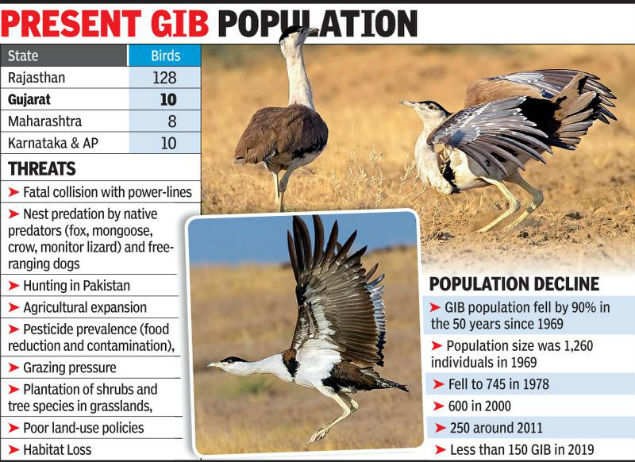Description
Context
- The government has said there are no Great Indian Bustards in Kutch Bustard Sanctuary in Gujarat Kutch, a claim that has raised eyebrows among conservationists and wildlife enthusiasts.
Great Indian Bustards and their habitats
- GIBs are the largest among the four bustard species found in India, the other three being MacQueen’s bustard, lesser florican and the Bengal florican.
- GIBs’ historic range included much of the Indian sub-continent but it has now shrunken to just 10 per cent of it.
- Among the heaviest birds with flight, GIBs prefer grasslands as their habitats.
- Being terrestrial birds, they spend most of their time on the ground with occasional flights to go from one part of their habitat to the other.
- They feed on insects, lizards, grass seeds
- GIBs are considered the flagship bird species of grassland and hence barometers of the health of grassland ecosystems.

On the brink of extinction
- Central government had told the 13th Conference of Parties to the United Nations Convention on Migratory Species of Wild Animals (CMS) held in Gandhinagar, that the GIB population in India had fallen to just 150.
- Of them 128 birds were in Rajasthan, 10 in Kutch district of Gujarat and a few in Maharashtra, Karnataka and Andhra Pradesh.
- Pakistan is also believed to host a few GIBs.
- Due to the species’ smaller population size, the International Union for Conservation of Nature (IUCN) has categorised GIBs as critically endangered, thus on the brink of extinction from the wild.
Threats
- Scientists have been pointing out overhead power transmission lines as the biggest threat to the GIBs. Birds due to their poor frontal vision, can’t detect powerlines in time and their weight make in-flight quick manoeuvres difficult.
- Change in landscape by way of farmers cultivating their land, which otherwise used to remain fallow due to frequent droughts in Kutch.
- Cultivation of cotton and wheat instead of pulses and fodder are reasons for falling GIB numbers.
Why no bustard in KBS?
- KBS is a tiny sanctuary notified in 1992 and spread over just two square kilometres (sqkm).
- But its eco-sensitive zone covers most of present-day core GIB habitat.
- Kutch Bustard Sanctuary is also known as Lala–Parjan Sanctuary, is located in Gujarat, India. This sanctuary is one of the two great Indian bustard sanctuaries in Gujarat; the other one is in
- It was declared as a sanctuary, specifically for the conservation of the great Indian bustard, the heaviest flying bird.
- The main bird species of the sanctuary, the great Indian bustard, locally called “Ghorad,” is a Schedule I bird under the Indian Wildlife Protection Act of 1972.
- The sanctuary lies in the ecological zone of the semi desert region. Hence, the climate is arid, rainfall is meagre and erratic, with an average annual precipitation of 384 millimetres (15.1 in).
- The creation of this safe-haven for the birds led to an increase in the GIB population in KBS—from 30 in 1999 to 45 in 2007.
- But windmills and powerlines started coming up right on the borders of the sanctuary from 2008 onward and GIB numbers started dwindling.
Supreme Court’s intervention
- In response to a petition, the Supreme Court ordered that all overhead power transmission lines in core and potential GIB habitats in Rajasthan and Gujarat should be undergrounded.
- The SC also formed a three-member committee, including Devesh Gadhvi, the member of the bustard specialist group of IUCN, to help power companies comply with the order.
Conservation measures
- In 2015, the Central government launched the GIB species recovery programme.
- Under the programme, the WII and Rajasthan forest department have jointly set up conservation breeding centres where GIB eggs harvested from the wild are incubated artificially and hatchlings raised in controlled environment.
https://indianexpress.com/article/explained/explained-great-indian-bustards-of-kutch-their-habitats-existential-threat-7417139/





